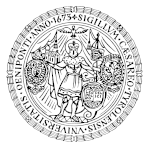University of Innsbruck
| Leopold-Franzens-Universität Innsbruck | |
 |
|
| Latin: Universitas Leopoldino Franciscea, also called Alma Mater Oenipontana | |
| Type | Public |
|---|---|
| Established | 1669 (as a university) |
| Rector | Tilmann Märk |
|
Academic staff
|
3,164 (227 professors) |
|
Administrative staff
|
1,383 |
| Students | 27,774 |
| Location |
Innsbruck, Austria 47°15′46″N 11°23′4″E / 47.26278°N 11.38444°ECoordinates: 47°15′46″N 11°23′4″E / 47.26278°N 11.38444°E |
| Campus | Urban |
| Website | www |
The University of Innsbruck (German: Leopold-Franzens-Universität Innsbruck; Latin: Universitas Leopoldino Franciscea) is a public university in Innsbruck, the capital of the Austrian federal state of Tyrol, founded in 1669.
It is currently the largest education facility in the Austrian Bundesland of Tirol, the third largest in Austria behind Vienna University and the University of Graz and according to The Times Higher Education Supplement World Ranking 2010 Austria's leading university. Significant contributions have been made in many branches, most of all in the physics department. Further, regarding the number of Web of Science-listed publications, it occupies the third rank worldwide in the area of mountain research.
In 1562 a Jesuit grammar school was established in Innsbruck by Peter Canisius, today called "Akademisches Gymnasium Innsbruck". It was financed by the salt mines in Hall in Tirol, and was refounded as a university in 1669 by Leopold I with four faculties. In 1782 this was reduced to a mere lyceum (as were all other Universities in the Austrian Empire, apart from Prague, Vienna and Lviv), but it was reestablished as the University of Innsbruck in 1826 by Emperor Franz I. The university is therefore named after both of its founding fathers with the official title "Leopold-Franzens-Universität Innsbruck" (Universitas Leopoldino-Franciscea).
...
Wikipedia
